#north west cambridgeshire
Explore tagged Tumblr posts
Text

A reminder that every vote does count. Seven constituencies in Britain's general election were decided by fewer than 100 votes.
One of the winners in those constituencies was 22-year-old Sam Carling who defeated Conservative Shailesh Vara in North West Cambridgeshire.
Sam Carling: Meet the new youngest MP, born in 2002
In Poole, Conservative Sir Robert Syms had been an MP since 1997 until he was beaten by Labour's Neil Duncan-Jordan by 18 votes; there needed to be three recounts to determine that result.
BTW, the race which hadn't been called at the time the chart was created was finally called on Saturday. Skye and West Ross-shire was won by the Lib Dems by 2,160 votes.
It's time to dust off the classic Nick Anderson cartoon about voting.

Oh yeah, France just avoided getting a far right government because voter turnout in Sunday's legislative election was unusually high.
#vote!#voting makes a difference#uk#2024 uk general election#narrow victories#poole#north west cambridgeshire#sam carling#labour#civics#democracy#never miss an election
20 notes
·
View notes
Text
ELECTION NIGHT ENGLAND 2024

composition of all councils circa 2023:
🌹Labour: 5609
🌳Tory: 5395
🕊️Liberal: 2804
🌻Green: 757
💩Reform: 10
🔥Liberal (1989): 5
���Transform: 4
💩SDP (1990): 2
Regionalists, RAs and Others: 1663
these numbers do not include changes over the past year or so – including a number of labour councillors who’ve left the party due to the centralist agenda and the leadership’s support for the genocide
TONIGHT’S ELECTIONS:
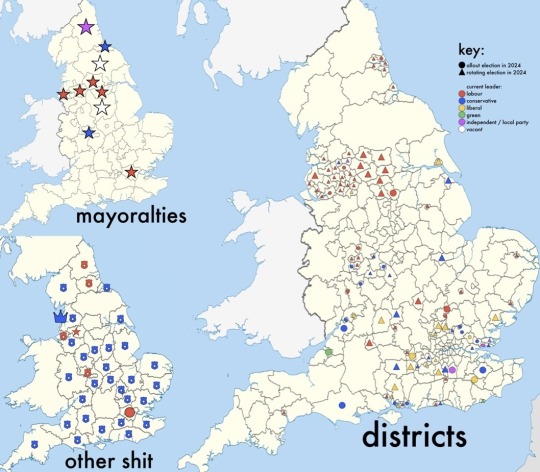
every mayor bar cambridgeshire and the “West of England”
every police commissioner
multiple district councils
london assembly
blackpool south byelection
borough mayor of salford
SEATS UP TONIGHT:
🌳Tory: 989
🌹Labour: 973
🕊️Liberal: 418
🌻Green: 107
Regionalists, RAs and Others: 172
ALLOUT ELECTIONS (all seats are to be elected, whole council can flip): Basildon, Brentwood, Bristol, Cannock Chase, Castle Point, Cheltenham, Dorset, Dudley, Epping Forest, Fareham, Gloucester, Harlow, Havant, North Herts, Maidstone, Nuneaton, Reddit, Rossendale, Rotherham, Stevenage, Stroud, Tandridge, Tunbridge Wells, North Tyne, Warrington, Wokingham, Worcester
PARTIAL / ROTATING ELECTIONS where enough seats are being contested to potentially flip the council, ignoring labour majority defences (bold/italic councils could only be changed to no overall control): Adur, Basingstoke, Bolton, Burnley, Cherwell, Colchester, Elmbridge, Hastings, Hart, Hyndburn, Norwich, Sheffield, Solihull, Stockport, Walsall, Hartlepool, Hull, Milton Keynes, Oxford, West Oxon, Pendle, Peterborough, Portsmouth, Rochford, Rugby, Southend, Tamworth, Thurrock, Welwyn Hatfield
50 notes
·
View notes
Text






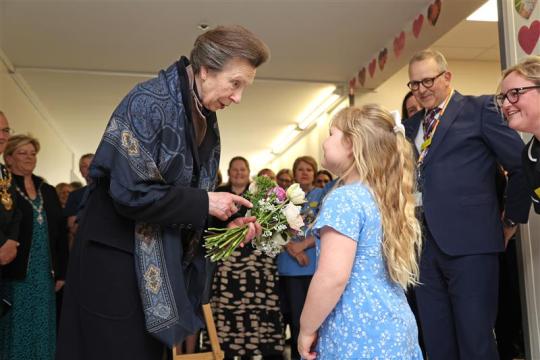

Princess Anne, as Patron of the Royal College of Midwives, visited North West Anglia NHS Foundation Trust in Cambridgeshire, on 25 April 2024.
22 notes
·
View notes
Text
Em's County OC Intros!!
🏴🏴🏴🏴🏴🏴🏴🏴🏴🏴🏴
These are my UK County OCs. Some are still a work in progress. I, myself am from the East Midlands so they're my most developed characters.
Counties in England are like states in the USA. For example, 'Staffordshire' is of the same status within the UK as 'Massachusetts' does in America!
If anyone has any suggestions or questions, leave them in my ask box and I'll 100% reply!
----------------------------------------------
East Midlands
Derbyshire - Elizabeth Kirkland
Leicestershire - James Kirkland
Lincolnshire** - Henry Kirkland
Northamptonshire - William Kirkland
Nottinghamshire - Adelaide Kirkland
Rutland - Teagan Kirkland
North Lincolnshire - Jack Kirkland
North East Lincolnshire - Ella Kirkland
West Midlands
Staffordshire - Mason Kirkland
Warwickshire - Fran Kirkland
Shropshire - Alexander Kirkland
Herefordshire - Darla Kirkland
Worcestershire - Benjamin Kirkland
North West
Lancashire - Alfie Kirkland
Merseyside - Jude Kirkland
Cumbria - Cleo Kirkland
Cheshire - Jess Kirkland
London
Greater London - Charlotte Kirkland
North East
Northumberland** - Daniel Kirkland
Tyne - David Kirkland
Wear - Georgia Kirkland
Durham - Lottie Kirkland
South West
Oxfordshire - Katherine Kirkland
Somerset - Eleanor Kirkland
Cornwall** - Elestren Southcott-Kirkland
Devon - Barney Kirkland
Dorset - Callum Kirkland
East Anglia
Cambridgeshire - Louis Kirkland
Norfolk - George Kirkland
Suffolk - Edith Kirkland
Scottish Islands
Orkney - Anya Kirkland-Bondevik
Shetland - Charlie Kirkland-Bondevik
Skye - Lillian Kirkland-Bondevik
Barra - Katie Kirkland-Bondevik
Yorkshire
South Yorkshire - Thomas Kirkland
North Yorkshire - Isaac Kirkland
West Yorkshire - Natalie Kirkland
East Riding of Yorkshire - Dana Kirkland
South East
Berkshire - Darren Kirkland
Essex** - Summer Kirkland
Hertfordshire - Joanna Kirkland
Kent** - Joshua Kirkland
Surrey - Maximilian Kirkland
Bedfordshire - Alison Kirkland
Hampshire - Nicole Kirkland
East Sussex - Theodore Kirkland
West Sussex - Candice Kirkland
Isle of Wight - Claire Kirkland
**Ex-nations
7 notes
·
View notes
Text
Commons leader Penny Mordaunt and former minister Jacob Rees-Mogg are among senior Tories to have lost their seats, as the party suffers a heavy election defeat.
Ms Mordaunt, who was tipped as a future Tory leadership contender, saw her majority of more than 15,000 overturned in Portsmouth North.
Mr Rees-Mogg, a former business secretary, lost in North East Somerset and Hanham, with Labour overturning his 16,000 majority.
He told the BBC he wouldn't "blame anybody other than myself" and that it had been "a very bad night for the Conservatives".
Defence Secretary Grant Shapps, Justice Secretary Alex Chalk and Michelle Donelan are among a clutch of cabinet ministers to lose their seats.
But Chancellor Jeremy Hunt, who had been seen as vulnerable in his Godalming and Ash constituency, managed to hold on with slender 891 majority.
'Sobering verdict'
Prime Minister Rishi Sunak conceded the election, speaking after he was re-elected in Richmond and Northallerton.
He said the electorate had “delivered a sobering verdict” on the Tories, and apologised to those in his party who had lost their seats. He said he had called Labour leader Sir Keir Starmer to congratulate him on winning.
Speaking after losing her seat, Ms Mordaunt said her party had "taken a battering because it failed to honour the trust that people had placed in it".
She warned against "talking to an ever smaller slice of ourselves," adding, "if we want again to be the natural party of government, then our values must be the people's".
In other high profile Tory losses:
Veterans Minister Johnny Mercer lost to Labour in Plymouth Moor View
Education Secretary Gillian Keegan lost to the Liberal Democrats in Chichester, a West Sussex seat the Tories have held for a century
Culture Secretary Lucy Frazer lost Ely and East Cambridgeshire, also to the Liberal Democrats
Chief Whip Simon Hart - in charge of party discipline - lost to Plaid Cymru in Caerfyrddin, as the Tories lost all their seats in Wales
Former justice secretary Sir Robert Buckland, who also lost his seat, told the BBC his party faced "electoral Armageddon".
He said too many Conservatives had focused on "personal agendas and jockeying for position" instead of "concentrating on doing the job that they were elected to do".
"I've watched colleagues strike poses, write inflammatory op-eds, and say stupid things they have no evidence for, instead of concentrating on doing the job that they were elected to do," the former justice secretary said.
Asked whether he was referring to former home secretary Suella Braverman, who days before polls opened published an article in the Daily Telegraph strongly criticising the government, he said: "Yes, and I'm afraid that's not an isolated example."
"I'm fed up of personal agendas and jockeying for position. The truth is now with the Conservatives facing electoral Armageddon, it's going to be like a group of bald men arguing over a comb.
Sir Robert said for the party to move further to the right would be a "disastrous mistake" that "would send us into the abyss".
Speaking earlier, before his defeat, Sir Jacob said it was “clearly a terrible night” for his party, that had come to take its “core vote for granted”.
“We need to win voters at every single election. If you take your base for granted... your voters will look to other parties.”
He thought the party had made a mistake by ousting Boris Johnson, who led it to victory in the 2019 election but was forced to step down as prime minister in 2022 following a series of scandals.
Former cabinet office minister Steve Baker, who BBC projections gave less than a 1% chance of holding onto his seat, said his party was having an “incredibly difficult night”.
He said Rishi Sunak had a "brilliant mind" but acknowledged he had made mistakes during the campaign, including the decision to leave D-Day commemorations early.
15 notes
·
View notes
Text
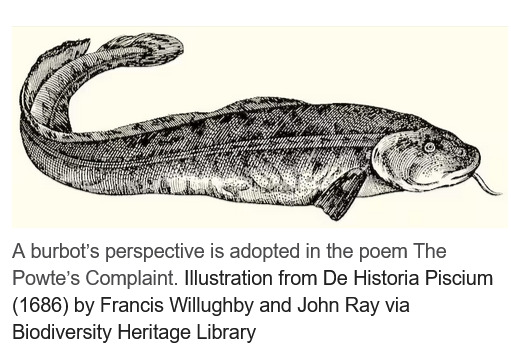
Travel back [...] a few hundred years to before the industrial revolution, and the wildlife of Britain and Ireland looks very different [...]. [B]etween 1529 and 1772 [...] [i]n the early modern period, wolves, beavers and probably some lynxes still survived in regions of Scotland and Ireland. [...] [T]he now globally extinct great auk could still be found on islands in the Outer Hebrides. [...] [A]nd pine martens and “Scottish” wildcats were also found in England and Wales. [...] [B]urbot and sturgeon in both rivers and at sea [...] [and] threatened molluscs like the freshwater pearl mussel and oyster were also far more widespread. [...] [S]everal species of wolf have gone extinct [...]. The capercaillie is [...] [t]oday [...] found only rarely in the north of Scotland, but 250-500 years ago it was recorded in the west of Ireland [...]. [B]y the end of the 18th century, sea eagles were essentially extinct across England and Wales. [...]
The Powte’s Complaint is a protest ballad probably written in 1619 to bewail the drainage of the Fens around Ely and Wisbech in Cambridgeshire.
Attributed in one manuscript to a “Peny” of Wisbech, it is written from the perspective of a burbot, a freshwater species of cod commonly found in the Fens at this time. (This fish is now nationally extinct, but may be soon be reintroduced.)
The ballad summons the “brethren of the water” - probably meaning local people as well as fish and other animals - to fight against the drainage scheme, which sought to create new pasture land:
Come, Brethren of the water, and let us all assemble,
To treat upon this matter, which makes us quake and tremble;
For we shall rue it if ’t be true that Fenns be undertaken,
And where we feed in Fen and Reed, they’ll feed both Beef and Bacon.
According to research by Todd Borlik and Clare Egan, the subject of complaint here was a plan to cut a canal through an area of common land south of Haddenham. This scheme would remove the ability of local people to catch fish, and also to transport their produce and fuel on the water. Protests against the scheme apparently culminated in a demonstration of some 2,000 people who lit bonfires, banged on drums and fired guns all night during a meeting of the Commission of Sewers in 1619.
Within the poem, the alliance of the “brethren of the water” seems to recognise the interdependence of humans and wildlife on each other, and on the environment of the Fens.
A comparable example [...] is the Welsh poem Coed Marchan (Marchan Wood), written around 1580 by Robin Clidro, a wandering poet from the Vale of Clwyd in Denbighshire, known for his humorous rhymes.
Clidro’s poem tells the story of a group of red squirrels who go to London to present a petition against the felling of Marchan Wood for charcoal. As with The Powte’s Complaint, the use of the squirrel as narrator is a conceit, and the poem is really a protest against deforestation on behalf of human interests. But again, the author re-imagines the world from the perspective of animals:
Odious and hard is the law, and painful to little squirrels. They go the whole way to London, with their cry and their matron before them. Then on her oath she said, “All Rhuthyn’s woods are ravaged; my house and barn were taken one dark night, and my store of nuts.” The squirrels all are calling for the trees; they fear the dog.
---
All text above by: Lee Raye. “Wildlife wonders of Britain and Ireland before the industrial revolution - my research reveals all the biodiversity we’ve lost.” The Conversation. 17 July 2023. Image and caption are shown unaltered as the originally appear published in/with the article. Published at: theconversation dot com /wildlife-wonders-of-britain-and-ireland-before-the-industrial-revolution-my-research-reveals-all-the-biodiversity-weve-lost-208721 [Bold emphasis and some paragraph breaks/contractions added by me. Presented here for commentary, teaching, criticism.]
56 notes
·
View notes
Text
Court Circular | 25th April 2024
St. James's Palace
The Princess Royal this afternoon attended "DNA Day" at Illumina Centre, 19 Granta Park, Great Abington, and was received by His Majesty's Lord-Lieutenant of Cambridgeshire (Mrs. Julie Spence).
Her Royal Highness later opened the National House Building Council's Apprenticeship Training Hub at Histon Football Club, Bridge Road, Impington, Cambridgeshire.
The Princess Royal, Patron, the Royal College of Midwives, subsequently visited North West Anglia NHS Foundation Trust, Hinchingbrooke Hospital Maternity Unit, Parkway Hinchingbrooke, Huntingdon, Cambridgeshire.
Her Royal Highness, Colonel, The Blues and Royals (Royal Horse Guards and 1st Dragoons), later visited The Household Cavalry Mounted Regiment at Hyde Park Barracks, Knightsbridge, London SW7.
The Princess Royal, Chancellor, University of London, this evening attended an Institute of Commonwealth Studies Reception at the Senate House, Malet Street, London WC1, to mark its Seventy Fifth Anniversary and was received by Ms. Roxanne Zand (Deputy Lieutenant of Greater London).
Her Royal Highness, Colonel, The Blues and Royals (Royal Horse Guards and 1st Dragoons), was represented by Brigadier Andrew Parker Bowles (former Commander, Household Cavalry) at the Memorial Service for General Sir Richard Vickers (former Commanding Officer, The Blues and Royals, Royal Horse Guards and 1st Dragoons, and former Equerry to The late Queen) which was held at the Guards Chapel, Wellington Barracks, Birdcage Walk, London SW1, this afternoon.
13 notes
·
View notes
Text
The Great Ouse: England's Historical Lifeline
The River Great Ouse is a remarkable watercourse in England, and the longest among several British rivers sharing the name "Ouse." Originating near Syresham in Northamptonshire, it flows across Buckinghamshire, Bedfordshire, Cambridgeshire, and Norfolk, finally emptying into the Wash and the North Sea near King's Lynn. There’s some debate regarding the exact length of the river, with estimates ranging between 143 miles (230 km) and 160 miles (260 km). Regardless, this meandering river is the fifth-longest in the UK, flowing mainly north and eastwards.

Historically significant for navigation and flood control, the Great Ouse has played a vital role in the region's development. The river’s most well-known tributary is the River Cam, which winds its way through the famed university town of Cambridge. Along its lower course, the Great Ouse runs through extensively modified wetlands, known as The Fens, and has been significantly altered over the centuries to manage water flow and reduce flooding risks.
The Name and Course of the River
The name "Ouse" is derived from the Celtic or pre-Celtic "Udso-s", meaning "water" or "slow-flowing river." This makes the name a bit redundant, as the word itself already implies water. The river's lower sections are often referred to by other names, including the "Old West River" and the "Ely Ouse", though the term "Great Ouse" is commonly used to distinguish it from smaller rivers also called Ouse.

The river begins its journey near the villages of Syresham and Wappenham, flows through Buckingham, passes through towns like Milton Keynes and Bedford, and eventually reaches the tidal part of the river around Earith. From here, the river splits into the Old Bedford and New Bedford Rivers, which were artificially constructed to provide quicker drainage to the sea. Finally, the river meets the Wash at King's Lynn, after passing through the Denver sluice, which regulates water levels.
Historical Importance
The Great Ouse has been crucial both as a navigable route and for draining the Fens for centuries. Its path has been altered multiple times throughout history, dating back as early as 1236, due to persistent flooding in the region. Major engineering projects, particularly during the 17th century, saw the construction of the Old Bedford River and New Bedford River, designed to expedite the flow of water towards the coast. In more recent times, the Cut-Off Channel and Great Ouse Relief Channel were added to manage water levels further and prevent flooding.
During its peak, the river facilitated significant commercial traffic, with barge transport playing a key role, especially for cargo like sugar beet. However, the river's use for navigation declined with the advent of railways, and it was declared derelict in the 1870s. By the 20th century, a variety of authorities, including the Great Ouse Catchment Board and Anglian Water Authority, took responsibility for maintaining the river.

A Natural Haven
The Ouse Washes, sandwiched between the Old and New Bedford Rivers, form one of the most significant wetland areas in the UK. These washlands are flooded during the winter months but used as pasture in the summer. This unique habitat is crucial for a range of wildlife, including lapwings, redshanks, and various duck and swan species. The region is internationally recognized for its ecological importance, providing essential breeding grounds for birds and a winter haven for migratory species.
Navigational History
The River Great Ouse has long been vital for both drainage and navigation, though balancing these roles hasn't always been straightforward. In prehistory, the river followed a different course, flowing from Huntingdon to Wisbech before reaching the sea. However, silting and flooding events, particularly in the 13th century, caused the river to breach its banks and carve out new courses, which led to its current path through Denver to King's Lynn.
In the 1600s, ambitious drainage schemes began, notably led by Cornelius Vermuyden, a Dutch engineer who oversaw the construction of the Old Bedford and New Bedford Rivers. These projects transformed the landscape but were controversial, as they sometimes hampered navigation. The Bedford Levels drainage project, spearheaded by the Earl of Bedford and a group of investors, further altered the river’s course.
In terms of navigation, significant improvements were made from the early 17th century onwards, including the construction of sluices and locks. The Denver sluice, a critical piece of infrastructure for managing water flow and navigation, was first built in the mid-1700s but had to be rebuilt several times due to failures. King’s Lynn, located at the river's mouth, grew as an important port thanks to the efforts of engineers like Charles Labelye.
Although the river's commercial role diminished with the rise of rail transport, it has found a new lease of life in leisure boating. Since the mid-20th century, efforts by groups like the Great Ouse Restoration Society have revitalized the river, ensuring its continued use for recreation and wildlife conservation.
0 notes
Text
Major Boost in UK Bathing Water Sites
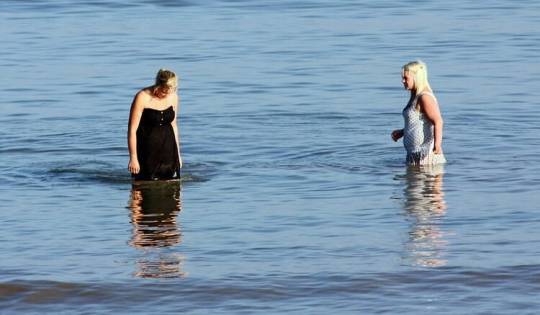
Government New Bathing Site Plans
In a significant stride towards improving the UK's water quality, the government has unveiled plans to consult on the establishment of dozens of new bathing water sites across England. This initiative marks the largest ever rollout of its kind, further underlining the government's commitment to enhancing the cleanliness and safety of the nation's aquatic environments. A Nationwide Consultation At the core of this initiative lies a two-week public consultation, actively fostering the voices of residents, bathers, businesses, and organizations to shape the future of England's bathing waters. Moreover, Water Minister Robbie Moore emphasizes the social, health, and wellbeing benefits that clean and accessible water bodies bring to communities, urging stakeholders to actively contribute to the consultation process. The Criteria for New Sites The selection of new bathing water sites is a meticulous process, prioritizing locations with significant bathing activity and the necessary infrastructure, such as public toilets. The Department for Environment, Food & Rural Affairs (Defra) ensures that only sites meeting these stringent criteria progress to public consultation, ensuring that the new designations will serve the needs and safety of the public effectively. The sites being considered for designation are: Location County/Area Church Cliff Beach Lyme Regis, Dorset Coastguards Beach River Erme, Devon Coniston Boating Centre Coniston Water, Cumbria Coniston Brown Howe Coniston Water, Cumbria Littlehaven Beach Tyne and Wear Manningtree Beach Essex Monk Coniston Coniston Water, Cumbria River Avon at Fordingbridge Hampshire River Cam at Sheep’s Green Cambridge, Cambridgeshire River Dart Estuary at Dittisham Devon River Dart Estuary at Steamer Quay Totnes, Devon River Dart Estuary at Stoke Gabriel Devon River Dart Estuary at Warfleet Dartmouth, Devon River Frome at Farleigh Hungerford Somerset River Nidd at the Lido Leisure Park Knaresborough, North Yorkshire River Ribble at Edisford Bridge Lancashire River Severn at Ironbridge Shropshire River Severn at Shrewsbury Shropshire River Stour at Sudbury Suffolk River Teme at Ludlow Shropshire River Tone in French Weir Park Taunton, Somerset Wallingford Beach River Thames, Berkshire Derwent Water, Crow Park Keswick, Cumbria River Wharfe at Wetherby Riverside West Yorkshire Goring Beach Worthing, West Sussex Worthing Beach House Worthing, West Sussex Rottingdean Beach Rottingdean, East Sussex Improvements and Accountability The initiative builds on recent advancements in water management and pollution control. Among these improvements are enhanced regulatory capacities, comprehensive monitoring of storm overflows, and significant investments in water infrastructure. These measures not only aim to reduce pollution but also to hold water companies accountable for environmental breaches, with the introduction of stricter penalties and a ban on executive bonuses for non-compliance. Engagement and Action The consultation period presents a unique opportunity for the public to influence the selection and management of new bathing water sites. The stakeholders have until March 10 to share their insights actively, ensuring that the expansion of designated bathing areas aligns with community needs and environmental sustainability goals.
In Conclusion
The government's plan to roll out new bathing water sites is a testament to its dedication to environmental excellence and public health. By fostering community involvement and implementing rigorous quality standards, this initiative promises to not only enhance the UK's natural landscapes but also to strengthen the nation's commitment to a sustainable and healthy future. Sources: THX News & Department for Environment, Food & Rural Affairs. Read the full article
#bathingwaterqualityimprovement#communityengagementinwaterquality#designatedswimmingspots#EnvironmentAgencymonitoring#environmentalwatermanagement#thxnews#UKbathingwatersites#watercompanyaccountability#waterpollutioncontrolmeasures#waterqualitystandards
0 notes
Text
No Service Cremations in Ipswich

No Service Cremation in Ipswich is a funeral option that doesn’t include a ceremony, viewing or service. Instead, the body is simply transferred from a hospital to the crematorium in a cardboard casket.
This can help families save money on a funeral while still saying their final farewells. Here are a few things to consider before choosing this service. To know more about No Service Cremations in Ipswich, visit the Farewell Funerals website or call 0404660974.
There are many reasons why families choose direct cremation. These could be ethical, financial or practical. The person who has died may have specified they would like a cremation rather than a burial, or the family may choose to omit any ceremony.
Direct cremation can be arranged at Sevenhills Crematorium (Nacton) or West Suffolk Crematorium (Bury St Edmunds). If you wish to have a service there are three options available, including a basic funeral package which includes the use of a chapel and a professional photo tribute.
The county of Suffolk is known for its painters, with Thomas Gainsborough and John Constable hailing from the area, which is often referred to as ‘Constable Country’. Other well-known figures from the county include landscape designer Humphry Repton, suffragette Dame Millicent Garrett Fawcett and tuberculosis pioneer Jane Walker. It is also the birthplace of actor Sir John Mills. The county is home to a number of universities, including University Campus Suffolk.
Suffolk is a county in England, bordered by Norfolk to the north, the North Sea to the east, Essex to the south and Cambridgeshire to the west. Its principal town is Ipswich. Famous people from Suffolk include the landscape designer Humphry Repton; suffragette Dame Millicent Garrett Fawcett; and the captain of HMS Beagle, Robert FitzRoy.
Cremation services are often less expensive than traditional funerals as they do not involve embalming or a viewing or visitation. There are several types of cremation service to choose from, including a complete cremation service which includes a funeral service, a memorial service, or just direct cremation.
There are three crematoriums in Suffolk Sevenhills (Nacton), Ipswich and West Suffolk Crematorium (Bury St Edmunds). Each service is allocated a maximum of 30 minutes chapel time, however double times can be booked in advance where a large attendance is expected. Services are conducted by a celebrant and fees also include use of the chapel, music supplied by Obitus, a doctor's fee, government environmental surcharge, a bio-urn and 25 printed Orders of Service.
Unlike a funeral the coffin isn’t moved at this service and remains hidden from view behind curtains. The service itself can include poems, readings or prayers and is a chance for family and friends to say their final goodbyes.
Attendees may arrive as part of a procession or individually and can also offer personal words during the ceremony. This opportunity to pay your respects can help you come to terms with your loss.
A committal ceremony is normally shorter than a funeral and can be religious or non-religious. It is an ideal choice for people who prefer not to hold a funeral or prefer a more simple and private service. It is often held at a crematorium but can also take place at a churchyard, columbarium niches or special gardens. Alternatively the deceased can be buried directly without a service at all.
If a family wishes to have a service after the cremation they can do so and there are many options available. This includes a memorial service without the coffin present, a celebration of life service or even a funeral.
It’s important to note that only the next of kin or person authorised can collect the cremains after a committal. The cremation provider will keep the ashes for up to 4 years in their secure storage facility.
The cost of a No Service Cremation at Farewell Funerals starts from £1,000. This price covers all the funeral director’s professional fees, the cremation fee and a choice of coffin along with a funeral ceremony at either a church or venue of your choosing. This also includes a memorial booklet, condolence book and 25 printed orders of service. Each service is allocated a maximum of 30 minutes chapel time, but additional chapel time can be booked for larger services. To know more about No Service Cremations in Ipswich, visit the Farewell Funerals website or call 0404660974.
#farewell funerals in the gold coast#farewell funerals in logan#no service cremations in brisbane#farewell funerals in brisbane#no service cremations in logan#cremation services in brisbane#farewell funerals#farewell funerals in ipswich#no service cremations in ipswich#farewell funerals in redlands#No Service Cremations in Ipswich#Baby Cremation Services in Brisbane#Farewell Funerals#Farewell Funerals in Brisbane
0 notes
Text
A moment of silence for the recently edited-down Wikipedia list of woodlouse common names, and an appreciation of what it used to be:
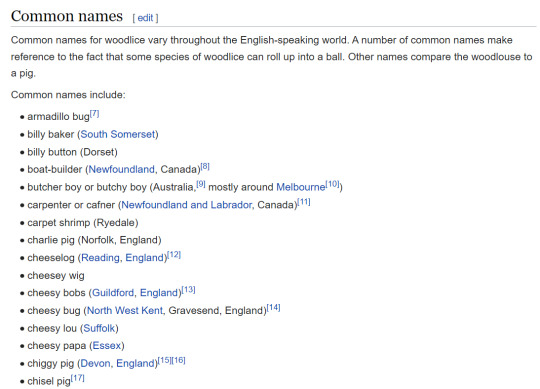

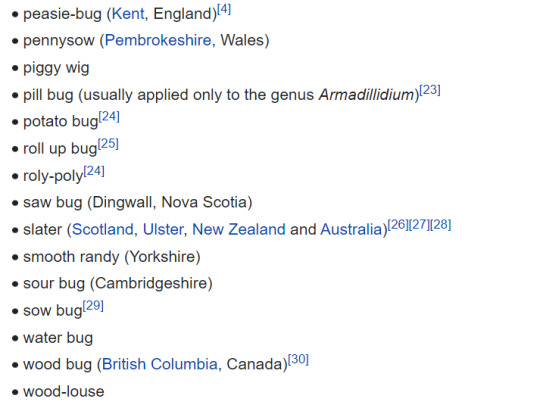
ID and text version below the cut (I’m new to this so if anyone has any tips on how to format this better for screen readers I would be very grateful to listen!):
[ID: A series of screenshots of an outdated Wikipedia page listing common names for woodlice. End ID]
Common names
Common names for woodlice vary throughout the English-speaking world. A number of common names make reference to the fact that some species of woodlice can roll up into a ball. Other names compare the woodlouse to a pig.
Common names include:
armadillo bug
billy baker (South Somerset)
billy button (Dorset)
boat-builder (Newfoundland, Canada)
butcher boy or butchy boy (Australia, mostly around Melbourne)
carpenter or cafner (Newfoundland and Labrador, Canada)
carpet shrimp (Ryedale)
charlie pig (Norfolk, England)
cheeselog (Reading, England)
cheesey wig
cheesy bobs (Guildford, England)
cheesy bug (North West Kent, Gravesend, England)
cheesy lou (Suffolk)
cheesy papa (Essex)
chiggy pig (Devon, England)
chisel pig
chucky pig (Devon, Gloucestershire, Herefordshire, England)
chuggy pig
crawley baker (Dorset)
daddy grampher (North Somerset)
damp beetle (North East England)
doodlebug (also used for the larva of an antlion)
fat pigs (Cork, Ireland),
gramersow (Cornwall, England)
granny grey (Wales)
granny grunter (Isle of Man)
grumper-pig (Bermuda)
hardback (Humberside, England)
hobbling Andrew (Oxfordshire, England)
hobby horse (Isle of Purbeck, Dorset, England)
hog-louse
horton bug (Deal, Kent, England)
humidity bug (Ontario, Canada)
jomits (Cloneganna)
menace (Plymouth, Devon)
mochyn coed (tree pig), pryf lludw (ash bug), granny grey in Wales
monkey-peas (Kent, England)
pea bug (Medway, England)
peasie-bug (Kent, England)
pennysow (Pembrokeshire, Wales)
piggy wig
pill bug (usually applied only to the genus Armadillidium)
potato bug
roll up bug
roly-poly
saw bug (Dingwall, Nova Scotia)
slater (Scotland, Ulster, New Zealand and Australia)
smooth randy (Yorkshire)
sour bug (Cambridgeshire)
sow bug
water bug
wood bug (British Columbia, Canada)
wood-louse
1 note
·
View note
Text
Tories hold North East Cambridgeshire.
Lab hold Newcastle upon Tyne North, Leicester West & Luton North.
Labour hold Makerfield, Gower, Ashton-under-Lyne, and Tooting.
Labour gain West Dunbartonshire from SNP.
Labour gain Bishop Auckland from Tories.
123 notes
·
View notes
Photo

Susie Steiner, who has died aged 51, three years after being diagnosed with incurable brain cancer, was once asked how similar she was to Detective Sergeant Manon Bradshaw, the member of the Cambridgeshire Major Incident Team first encountered by readers in her 2016 novel Missing, Presumed. “Manon is only 98.34% me – the rest is pure invention,” she responded.
Although she was evidently joking – she had never been a police officer, and nor was she unhappily embroiled in the world of internet dating, as Manon is at the beginning of her fictional life – her answer had a core of truth. It was Steiner’s interest and intuitive understanding of the dynamics between people, her ability to be alive to the complexities of their desires and their frailties, and her commitment to exploring questions of justice and equality, that animated her protagonist and made her so memorable.
DS, and later DI, Bradshaw – her unusual first name, readers learn, is the Hebrew for “bitter”, and a caprice by her mother – had three outings: Missing, Presumed, which centred on the abduction of a young woman whose well-to-do parents are friends with the home secretary, placing the investigative team under increased pressure; Persons Unknown (2017), in which Bradshaw’s adopted son, who is black, is arrested on suspicion of murder, and which was inspired by a real case; and Remain Silent (2020), published not long after the beginning of lockdown, which explores a violent death in the Lithuanian migrant worker community and which also sees Bradshaw faced with her partner’s cancer diagnosis.
Steiner, unbeknown to her, had written Remain Silent with “a 9cm tumour pushing my brain over its midline” and, in a piece she wrote about writing, cancer and lockdown, she described wishing she could have included the specificity of her treatment in the novel: the hard chairs in waiting rooms, the contrast between vigorous medical staff and depleted patients.
The impulse to capture detail was typical of her writing. Born in north London, the daughter of two psychoanalysts, Deborah (nee Pickering) and John Steiner, Susie went to Henrietta Barnett school and read English at York University before embarking on a career in journalism. She started out at the Hendon and Finchley Times before stints at the Times and the Telegraph led her to a job as a features editor and writer at the Guardian in 2001.
She remained at the paper for 11 years, although she was out of the office at a writing retreat in Devon when she spotted a poster on the kitchen wall bearing the words Keep Calm and Carry On. She discovered that it had originated in an independent bookshop in Alnwick, which she contacted so that she could recommend it to readers of Weekend magazine.
She was cheered, she later recalled, by its “message of stoicism and patience”, although its phenomenal popularity also prompted her to insist, semi-humorously, that she could not be blamed for its subsequent ubiquity. (Posters were clearly something that caught her eye: in Persons Unknown, she introduces the shopkeeper Birdie Fielding, who often consults one emblazoned with the image of Tony Blair for advice. Birdie cropped up in a piece that Steiner wrote about the perils of “writer’s butt”: “While some authors’ fantasies are about sex and death, mine are very much centred on unfettered access to the crisps aisle. I dwell on Frazzles a lot in this novel. As Birdie says: ‘Whoever said nothing tastes as good as skinny feels, has never set in on her third mince pie.’”)
While at the Guardian, Steiner met the journalist Tom Happold (who is now director of the creative video agency Happen Digital); they married in 2006, settled in West Hampstead and had two sons, George and Ben. Steiner, her husband told me, had always wanted to have children and was a very loving mother; and the compassion and empathy with which she portrayed Manon Bradshaw’s experience of single life and childlessness, after which she first adopts a child and later becomes pregnant, is striking.
She worked on her first novel, Homecoming (2013), for several years, drawing on her knowledge of the North York Moors, where she and Happold had a cottage, to create a multi-generational portrait of a farming family. But it was with the Bradshaw series that she really found her fictional feet, earning praise from readers, reviewers, her fellow crime writers and prize juries; she was twice shortlisted for the Theakston Old Peculier novel of the year award, and Missing, Presumed was selected for a slot in the Richard & Judy Book Club. A great admirer of Kate Atkinson’s Jackson Brodie novels, she too had the ability of combining strong characterisation with social commentary, and folding both into a compelling plot.
She faced challenges that, like the poster she popularised, required stoicism and patience. Steiner suffered from a hereditary and degenerative sight condition, retinitis pigmentosa, which was diagnosed in childhood and worsened in adult life; in 2013, she was registered blind. Her friend the novelist Lissa Evans described fast-paced walks on Hampstead Heath, in which she would forget that Steiner had little vision, so engrossed were they both in their conversation; she was, said Evans, “so clever and funny, straightforward and kind, warm yet caustic, penetrating yet easy to talk to, a huge presence in an ordinary-sized person”.
In a piece for the Independent on Sunday about her blindness that cited Milton, Joyce and the mythological figure Tiresias, Steiner wrote fascinatingly about the links between her condition and writing, saying: “You are reliant on another’s help. You cannot dictate – you must wait. This is both frightening and difficult but, I believe, is of service to the writer.” It allowed her to appreciate, she was convinced, the sometimes invisible suffering of others.
The greatest blow was the discovery, in May 2019, of a grade 4 glioblastoma, after which she underwent six hours of brain surgery and months of radiation and chemotherapy; she wrote movingly of her situation both on social media and in print, retaining great humour even in exceptionally dark times.
She is survived by her husband and sons, her sister, Kate, and brother, Michael, and her parents.
🔔 Susan Elizabeth Steiner, writer and journalist, born 29 June 1971; died 2 July 2022
Daily inspiration. Discover more photos at http://justforbooks.tumblr.com
6 notes
·
View notes
Text
How to Keep Safe Your Car Battery?
The best way to keep your battery in top form is by using checking the electrolyte solution degrees inside it. If your vehicle battery is preservation-unfastened then it'll be sealed, but if now not then you may flip the engine off and dispose of the battery caps to check the degrees.

If the degrees are low then vehicle battery acid can be bought in small portions from stores, but as an opportunity, you can use distilled water. Using battery acid or distilled water you can fill the cells till it touches the bottom of the fill tube, however, be cautious now not to use an excessive amount of as the solution should leak and harm the battery. Always use hand and eye safety when managing battery acid. Wrong fuel in car can also be dangerous for the car’s engine.
#Wrong Fuel Service in East Sussex#Wrong Fuel Service in North West London#Wrong Fuel Service in Buckinghamshire#Wrong Fuel Service in Cambridgeshire#Wrong Fuel Service in Hampshire#Wrong Fuel Service in Oxfordshire
0 notes
Video
NVR Wansford Peterborough Cambridgeshire 22nd August 2021 por loose_grip_99 Por Flickr: Stanier Jubilee 4-6-0 45596 Bahamas on arrival at Wansford with a train from Peterborough. This immaculate engine is visiting the Nene Valley railway for two weeks between mainline railtour duties. Bahamas was built by the North British Locomotive Company and entered service with the London Midland & Scottish Railway in January 1935. The engine was initially allocated to Crewe before moving on to various sheds around the English area of the LMS including Carlisle Kingmoor, Grimethorpe and Millhouses in Sheffield. Finally, 45596 was allocated to Stockport Edgeley in 1962. The engine remained here for four years and after hauling a number of enthusiast’s specials was withdrawn from traffic and preserved. It is normally based at Ingrow on the KWVR in West Yorkshire.
6 notes
·
View notes
Text
WOODLICE
"Jomits" (Cloneganna)
"armadillo bug"[7]
"billy baker" (South Somerset)
Billy Button (Dorset)
Granny grey (Wales)
"boat-builder" (Newfoundland, Canada)[8]
"butcher boy" or "butchy boy" (Australia,[9] mostly around Melbourne[10])
Bunty Nathans (Western Australia)
"carpenter" or "cafner" (Newfoundland and Labrador, Canada)[11]
"carpet shrimp" (Ryedale)
"charlie pig" (Norfolk , England)
"cheeselog" (Reading, England)[12]
"cheesy bobs" (Guildford, England)[13]
"cheesy bug" (North West Kent, Gravesend, England)[14]
"cheesy lou" (Suffolk)
"cheesy papa" (Essex)
"cheesey wig"
"chiggy pig" (Devon, England)[15][16]
"chucky pig" (Devon, Gloucestershire, Herefordshire, England)[17]
"chuggy peg"
"crawley baker" (Dorset)
"daddy grampher" (North Somerset)
"damp beetle" (North East England)
"dandy postman" (Essex and East London)
"doodlebug" (also used for the larva of an antlion)[18]
"Fat Pigs" (Cork, Ireland),
"gramersow" (Cornwall, England)[19]
"Grumper-pig" (Bermuda)
"Mochyn Coed" (meaning "Tree Pig"), "Pryf lludw" (meaning "Ash fly"), "granny grey" in Wales[20]
"granny grunter" (Isle of Man)
"hardback" (Humberside, England)
"hobbling Andrew" (Oxfordshire, England)
"hog-louse"[21]
"horton bug" (Deal, Kent, England)
"humidity bug" (Ontario, Canada)
"menace" (Plymouth, Devon)
"monkey-peas" (Kent, England)[4]
"monk's louse" (transl. "munkelus", Norway)[22]
"parson's pig" (Isle of Man)[23]
"pea bug" or "peasie-bug" (Kent, England)[4]
"pennysow" (Pembrokeshire, Wales)
"piggy wig"
"pill bug" (usually applied only to the genus Armadillidium)[24]
"potato bug"[25]
"roll up bug"[26]
"roly-poly"[25]
"rosary bug" (Turkey)
"slater" (Scotland, Ulster, New Zealand and Australia)[27][28][29]
"saw bug" (Dingwall, Nova Scotia)
"sour bug" (Cambridgeshire)
"sow bug"[30]
"wood bug" (British Columbia, Canada)[31]
"wood-louse"
5 notes
·
View notes
